
You Can't Stomp on Us -- after a Rand Paul organizer did stomp
The evening of October 25 at a rally in Kentucky a young woman, who was a MoveOn.org member, attempted to get a photograph taken of herself handing an oppositional sign to Rand Paul. She did not make it. Instead organizers of the event threw her to the ground and stomped on her head. The local TV station caught the action and showed it to their audience, and from there it spread to YouTube in a version that was seen more than 70,000 times in the next week.
There was a firestorm of activity on Twitter after the event on the 25th. A search for "Rand Paul" found a total of 1106 messages for that evening of which 944 were about the event. It was almost a thousand expressions of horror that politics had come to this state of physical abuse. The next day the person who had stomped on the girl's head was identified, and a couple of days later he was charged with assault.
Several only somewhat overlapping streams of Twitter messages about this event were identified. The one I would like to focus on in this analysis is the stream that was generated in connection with MoveOn.org.
A MoveOn member was violently attacked by Rand Paul Supporters last night. Send Lauren get well wishes. wellwishes@moveon.org. Noon October 26, 2010
Speak out against right-wing tea party violence. You can't stomp on us! http://j.mp/cantstomp #KYsen, morning October 27, 2010
Sam Doumit of @SuicideGirls says "You Can't Stomp on Me" http://twitpic.com/31wxcx #dontstomp #KYsen 11:00 a.m. October 29,2010
These three appeared on the MoveOn Twitter profile page. The second, on October 27, included a url to a page with an invitation to upload a self photo that included the phrase "you can't stomp on us." They reported that many photos were uploaded though the exact number was not provided. The third was a tweet by Sam Doumit that appeared on the Twitter profile page.
On the 31st another theme was started that could be found by searching for RT and @MoveOn:
RT @newscorpse: #GlennBeck says that @MoveOn protester whose head was stomped by #RandPaul staffer "got just what she wanted" #WTF? #p2 #TopProg
These are the four tweets that could most easily be identified with MoveOn.org as an organization.
The figure shows the number of messages per day.
 |
There were no messages on the 25th. The message on the 26th prompted no retweets. There were 52 retweets on the 27th. They were all "You can't stomp on us!" On the 28th there were 139 tweets and on the 29th another 103. They were a mix of the "you can't stomp on us" and messages identified by "#dontstomp." There were only three messages on the 30th of October. And on the 31st there were nine messages about GlennBeck's response to the event.
The total was 306 which pales in comparison with the several thousand messages posted 'spontaneously,' and the more than 70,000 views of the video on YouTube. They happened as people saw the video of the person being stomped and wanted to express their horror, and then as they commented on the identification and the charge of assault against the person who had done the stomping. In most of the 'action' MoveOn.org was not to be found except when it was used to identify the person thrown to the ground and stomped on.
MoveOn.org has been a very successful organization utilizing two technologies of communication: their website and email. They use the website, as in this case, to provide people connected with the organization an opportunity to take action. Here the action was an expression of shock and opposition; You can't stomp on me, in the first person. They raise money, using email, for causes the people connected with them support. The have contests for videos expressing concern and support or opposition. They have been a very creative organization in the web 2.0 world.
However, they do not seem to have equally integrated the newest technologies of communication into their activities. According to their profile page they have 14,700 followers, but that is tiny compared to the millions on their mailing lists all of whom are potential followers on Twitter. And even as a member was attacked they only prompted 306 twitter messages.
What is missing in this account, however, is the followers of the people posting the 306 messages. I searched the profile pages of each of the tweeters for the number of their followers. Followers are people who receive all of the messages posted by the person they are following. If you have 779 followers, which is the average for the 306 posted messges, all 779 have an opportunity to see your post. Of course, there is no guarantee that the message will be read by all followers, but they did take the initiative to become a follower. Followers is an indication of the reach of these messages. In this case the reach was 233,583. That is not millions, but 779 is a big multiplier effect. As organizations come to understand the reach of microblogging messages they may want to take advantage of this vehicle of communication.
© G. R. Boynton
November 1, 2010